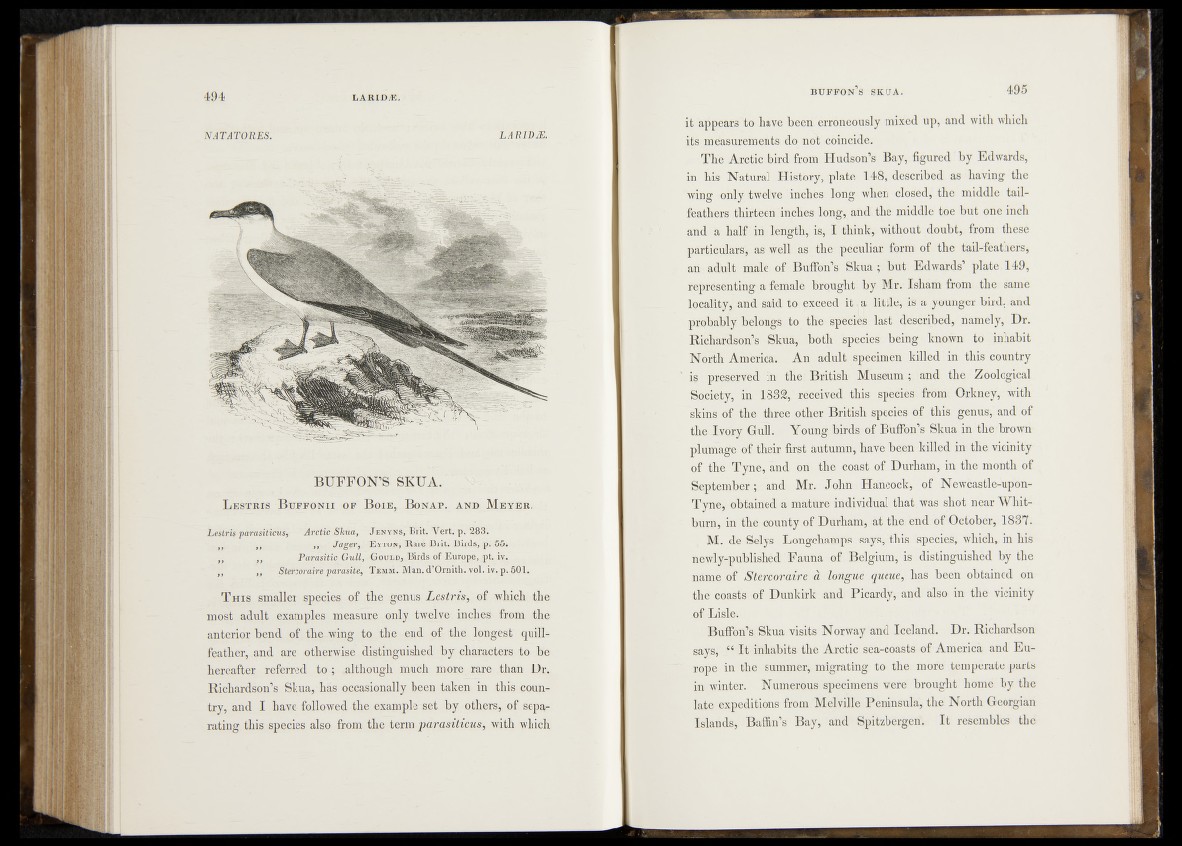
BU F FO N ’S SKUA.
L e s t r is B uefonii op B oie, B o-stap. and M e y e r .
Lestris parasiticus, Arctic Shun, J enyns, Biit.^Vert.p, 289.
H H j I Hj . ,, Jager, Eytojï, Karé Brit.- Ripjs, -p, §5.
„ ,, Parasitic Gully^GovvD} Birds of Europe, ;pt. iv.
If Stercoraire parasite, Temm. Man.d’Oinithrvöl. iy. p. §01.
T h i s smaller species of the genus Lestris, of which the
most adult examples measure only twelve.inches from the
anterior bend of the wing to the end of the longest quill-
feather, and are otherwise distinguished by characters to be
hereafter referred t o ; .although much’more rare than Dr.
Richardson’s Skua, has occasionally been taken in this country,
and I have followed the example set by others, of separating
this species also from the term parasiticus, with which
it appears to have been erroneously mixed up, and with which
its measurements do not coincide.
The Arctic bird from Hudson’s Bay, figured by Edwards,
in his Natural History, plate 148, described as having the
wing only twelve inches long when closed, the middle tail-
feathers thirteen inches long, and. the middle toe but one inch
and a half in . length, is, I think, without doubt, from these
particulars, as well as the peculiar form of the tail-feathers,
an adult male of Buffon’s Skua ; but Edwards’ plate 149,
representing a female brqUght by Mr. Isham from the same
lQcality?: and said to exceed it .a little, is a younger bird, and
probably belongs to the species last described, namely, Dr.
Richardson’s Skua, both species being known to inhabit
North America. An adult specimen killed in this country
i§ preserved:in. the;British Muséum ; and the Zoological
Society, in réceived. this, species from Orkney, with
"skins;of the three .other British species of this genus,: and of
the-lvory Gufl. Young, birds of Buffon’s Skua in the brown
plumage ofith&ir first autumn, have behn killed in the vicinity
of the Tyne', and on the coast of .Durham, in the month of
September;- and Mr. John Hancock, of Newcastle-upon-
Tyne, obtained a mature individual that was shot near W hitburn,
in'thé .county of Durham, at the; énd of October, 1837-
M. de Selys Longchamps . says, th is. species; which, in his
newly-publishéd Fauna of- Belgium, is distinguished by the
name’'óf Stercoraire à longue queue, has been obtained on
the coasts of Dunkirk and Picardy, and also in the vicinity
of Lisle;--«
Buffon’s. Skua visits Norway and Iceland. Dr. Richardson
- says; ƒ4 It inhabits the Arctic sea-coasts of America and Europe
in the summer,-migrating to the more temperate parts
in-winter. Numerous specimens were brought home by the
late expeditions from. Melville Peninsula, the North Georgian
Islands, Baffin’s Bay, and Spitzbergerf. It resembles the